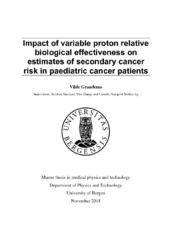| dc.contributor.author | Grandemo, Vilde | |
| dc.date.accessioned | 2018-12-13T16:08:14Z | |
| dc.date.available | 2018-12-13T16:08:14Z | |
| dc.date.issued | 2018-12-12 | |
| dc.date.submitted | 2018-12-11T23:00:07Z | |
| dc.identifier.uri | https://hdl.handle.net/1956/18763 | |
| dc.description.abstract | Background: Proton therapy has an increased dose-conformity compared to conventional radiotherapy with photons, and paediatric cancer patients receiving cranio-spinal irradiation (CSI) are routinely referred to this treatment modality. With long life-expectancy and enhanced radiosensitivity, children are at a significant risk of developing radiation-induced secondary cancers, emphasising the importance of secondary cancer risk estimations following proton therapy for these patients. Previous comparative studies on secondary cancer risk following proton and photon CSI treatment plans for paediatric cancer patients have based the proton risk estimates on a constant proton relative biological effectiveness (RBE) of 1.1. As the proton RBE varies with factors such as linear energy transfer (LET), dose, and tissue type, it is important to investigate how a variable proton RBE may affect the secondary cancer risk estimates for this patient group. Materials and methods: Proton CSI treatment plans for ten paediatric medulloblastoma patients were analysed with respect to the risk of radiation-induced secondary cancer of the lungs and thyroid by comparing risks predicted by the clinical proton RBE of 1.1 to the risk predictions of four variable RBE models (LET-weighted dose, the McNamara model, the Rørvik model, and the Wilkens model). By applying the organ equivalent dose (OED) concept to different dose-response scenarios, the lifetime attributable risk (LAR) and the excess absolute risk (EAR) were estimated based on age-, sex-, and site-specific risk coefficients gathered from epidemiological data on the Japanese A-bomb survivors. Results: All secondary cancer risk estimates were higher for the variable RBE models compared to the constant RBE of 1.1 for both organ sites, independent of dose-response relationship used. The risk predictions were highest with the variable RBE models that used tissue parameters corresponding to late reacting tissues which, depending on chosen organ site and dose-response relationship applied, predicted a 9 to 47% increase in risk from the constant RBE estimates. Conclusion: Regardless of risk model applied, the estimated risk of radiation-induced secondary cancer of the lungs and thyroid will increase when the proton RBE is variable and not constant. However, the enhanced secondary cancer risk estimates found in this thesis were not high enough to impact the conclusion made by previous studies: that proton CSI is the better option compared to photon CSI with respect to estimated secondary cancer risk for radiotherapy of paediatric medulloblastoma patients. | en_US |
| dc.language.iso | eng | eng |
| dc.publisher | The University of Bergen | en_US |
| dc.subject | Medisinsk fysikk | nob |
| dc.subject | Kreftrisiko | nob |
| dc.subject | Kreftbehandling | nob |
| dc.subject | Protonbehandling | nob |
| dc.title | Impact of variable proton relative biological effectiveness on estimates of secondary cancer risk in paediatric cancer patients | en_US |
| dc.type | Master thesis | |
| dc.date.updated | 2018-12-11T23:00:07Z | |
| dc.rights.holder | Copyright the Author. All rights reserved | en_US |
| dc.description.degree | Masteroppgave i fysikk | en_US |
| dc.description.localcode | MAMN-PHYS | |
| dc.description.localcode | PHYS399 | |
| dc.subject.realfagstermer | https://data.ub.uio.no/realfagstermer/c011455 | |
| dc.subject.realfagstermer | https://data.ub.uio.no/realfagstermer/c008928 | |
| dc.subject.realfagstermer | https://data.ub.uio.no/realfagstermer/c002005 | |
| dc.subject.realfagstermer | https://data.ub.uio.no/realfagstermer/c032041 | |
| dc.subject.nus | 752199 | eng |
| fs.subjectcode | PHYS399 | |
| fs.unitcode | 12-24-0 | |
